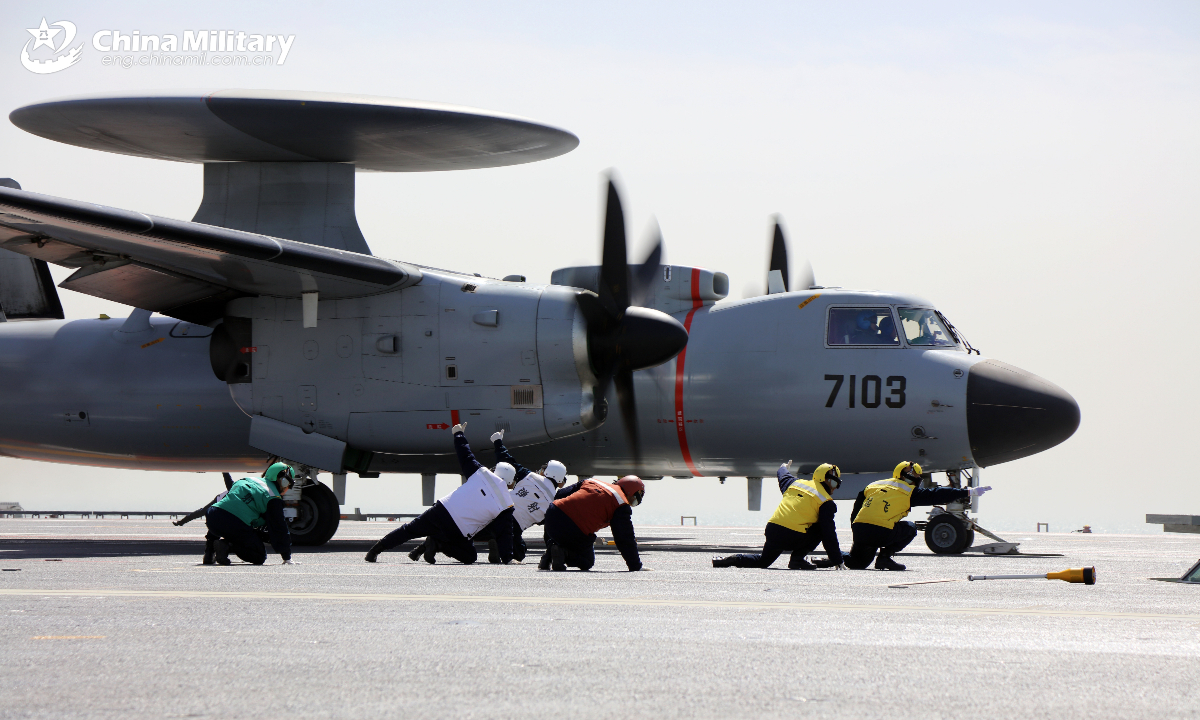By Liu Xuanzun

A KJ-600 early warning aircraft is ready to take off from China's first electromagnetic catapult-equipped aircraft carrier, the Fujian (Hull 18). Three types of aircraft recently completed their inaugural electromagnetic catapult-assisted takeoff and arrested landing trainings on the aircraft carrier.(eng.chinamil.com.cn/Photo by Ju Zhenhua)
A senior developer disclosed in an official media report on Sunday that China's KJ-600 carrier-borne early warning aircraft is nicknamed after Nezha, a figure from Chinese mythology. He also elaborated on key technical details, including how the aircraft's radome was maximized to boost its detection range.
The KJ-600 again captured public attention after official Chinese media on Friday revealed that the country's third aircraft carrier, the electromagnetic catapults-equipped Fujian, was officially commissioned on Wednesday. The aircraft was first unveiled as a key component of the Fujian's air wing at China's V-Day military parade held in Beijing on September 3.
Geng Yansheng, head of the First Aircraft Institute under the state-owned Aviation Industry Corporation of China (AVIC), said in an interview with the China Central Television (CCTV) on Sunday that the reason why the KJ-600 is nicknamed after Nezha is because that with the nacelles of the two engines and the landing gears, together with the nose, the aircraft appears to have three heads like Nezha.
The two foldable wings, combined with the four vertical tails, resemble Nezha's six arms. The circular radome is reminiscent of the Qiankunquan, a legendary bracelet held by Nezha, while the red paintings on the fuselage evoke the Huntianling, another legendary artifact of Nezha. A more vivid feature is the high-speed rotation of the propellers, which resembles the fenghuolun, or wind-and-fire wheels, under Nezha's feet.
According to the CCTV News report, as an airborne command post, the carrier-based early warning aircraft is primarily tasked with detecting, sensing, forming, and distributing information on the situational awareness of carrier formations. Additionally, it can undertake non-military missions, such as coordinating search and rescue operations at sea and managing airspace command and control.
Geng said that the KJ-600 features a large radome, which houses the early warning antennas. To achieve a substantial detection range, the frontal dimensions of the early warning antennas have been maximized. This large radome represents the extreme for an aircraft of this small size, pushing the limits in terms of the aircraft's center of gravity, aerodynamic performance, and controllability.
Zhang Xuefeng, a Chinese military affairs expert, explained why a large radome with max-sized antennas is significant. He told the Global Times that the KJ-600 can be described as a force multiplier for carrier-based aircraft in an aviation formation.
While China's aircraft carrier groups have destroyers and frigates for detection and early warning missions, long-range radars of these vessels face limitations in detecting extremely low-flying sea-skimming targets due to the curvature of the Earth.
"A key function of carrier-based early warning aircraft is to detect these ultra-low-altitude targets," Zhang said.
Fixed-wing early warning aircraft offer significantly longer endurance and can carry larger radars, enabling them to detect sea-skimming targets flying at low altitudes from much greater distances, thereby better ensuring the safety of the carrier group, Zhang said.
Another distinctive design feature lies in the KJ-600's vertical tails, the CCTV News report noted.
While conventional aircraft typically feature either a single or dual vertical tail configuration, the KJ-600 incorporates four vertical tails. This design enhances tail control capability and requires larger control surfaces. To comply with carrier deck and hangar height limitations, the four-tail solution was adopted, which is a technical approach specifically implemented to overcome geometric constraints, Geng said.
The developer further introduced that the aircraft's engine is specifically designed as a carrier-based model, requiring robust corrosion resistance. As a carrier-based aircraft operating on extremely short takeoff and landing pathways, it must execute a wave-off in the event of mechanical failure or arrested landing mishap. This demands instantaneous power surge capability, with all engine components engineered to withstand intense stresses from catapult launches, arrested landings, and the impact forces of deck landing.



